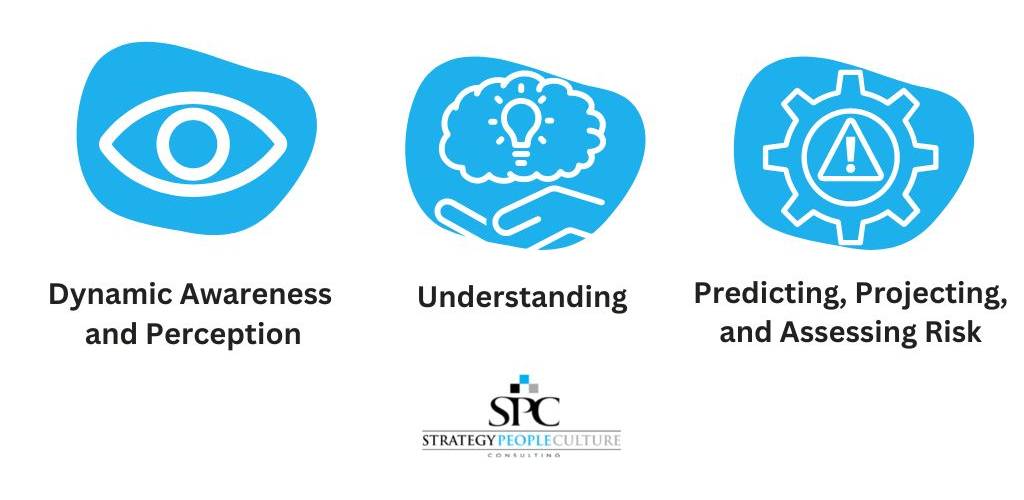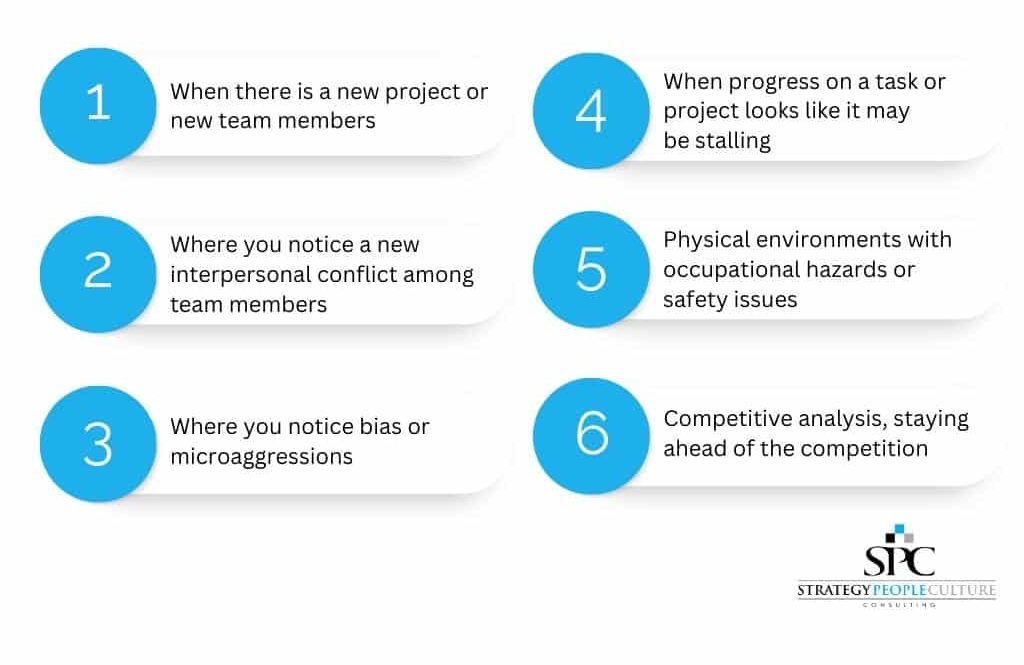Situational Awareness in Leadership: Reading the Room – Part 1

We’ve all encountered people like this: “those guys” who are so wrapped up in what they are doing that they are seemingly unconscious of how their action affects others. The slower driver who drifts in front of you on the freeway as you approach, even though, at that moment, you may be the only two cars in sight on a multi-lane road. The person who parks a shopping cart in the middle of the grocery aisle, preventing anyone else’s movement. The guy who’s having a loud phone conversation over private matters as he gets into a crowded elevator. Volkswagen has even created this humorous commercial featuring “those guys.”
What “those guys” probably lack is situational awareness. Whether it be just in that moment, or more of a habitual problem, lacking situational awareness is, at best, annoying and, at worst, the cause of some very poor decision-making. Clearly, then, it is an essential skill for leaders. Here, we take a closer look.
What is Situational Awareness?
Situational awareness (or situation awareness) is a complex concept. It has no easy synonym because it consists of three characteristics that must interplay. Someone with well-developed situational awareness can:
(1) completely perceive all elements of their surroundings and their relationship to each other,
(2) “read” or understand and assess their meaning, and
(3) accurately predict their future status for the purpose of taking or avoiding action.
If that seems like a lot, it is! Yet we commonly do exactly this when we drive defensively or even play a game of chess. If it seems related to strategy to you, then you would be correct.

In fact, the concept of situational awareness is well-studied in military applications and issues of national defense for that reason. Without a high level of situational awareness, developing an effective strategy is impossible.
According to the website humanfactors101.com, “Situation awareness is therefore about proactively staying ahead of the situation.” That is, it is all about timing. Because it is so critical to informed decision-making, it especially determines how competent someone is at making good decisions quickly.
What Does it Take to be Situationally Aware?
The short answer is experience. That is, well-developed situational awareness requires a healthy dose of hindsight and analysis of prior experiences. Understanding how situational awareness works in the mind in real time reveals why these are important – it follows these three steps:

- Dynamic awareness and perception: A situationally aware person continuously uses their sight, hearing, and touch to perceive their surroundings and compares their perceptions to what we’ve experienced as “normal” – that is, they have a kind of continual background mental process that performs a regular reality check. In the case of defensive driving, for example, this is the step that monitors the road for lane drifters.
- Understanding: This step accurately determines what the current reality means through the lens of experience. While driving defensively, you see brake lights ahead and know there is traffic or an accident.
- Predicting, projecting, and assessing risk: This is the step where conclusions about the meaning or understanding of an event can be drawn. In defensive driving, you know you may have to come to a complete stop, or an accident will occur. So you apply the brakes. Maybe you put on your blinkers because your prediction also tells you that the person behind you may not be paying attention, and you may be slammed into from behind.
As you can see, the quick decision-making resulting from situational awareness relies on tapping into mental models or frameworks established over years of observation.
How Situational Awareness Matters to Leadership

While situational awareness is very much about our physical environment, it also has clear relevance to workplace “positions” as well. For example, it applies to interpersonal “positioning” or hierarchies in the workplace. And this is true whether the hierarchies are perceived (such as with issues of gender or ethnic inequality) or actual (such as superior/subordinate relationships). Furthermore, it applies to systematic “barriers” that make task completion difficult (like glitchy electronic tracking or payment systems or even an awkward physical office layout). These are all issues that are mitigated when leadership has good situational awareness.
And yet, research shows corporate leadership is often seen as tone-deaf to the issues of their employees. Improving situational awareness can make a huge positive difference in the day-to-day work lives of employees. (This is likely the appeal of the show Undercover Boss, which helps develop situational awareness in leadership through experiences as regular employees.) Whereas not all scenarios require the same level of situational awareness, there are a few key instances where leadership needs to bring its A-game.
1. When there is a new project or new team members
Teams, as well as leaders, need to have good situational awareness, and this relies on experience. Team members that are new to a project will have a natural learning curve and expectedly encounter issues or make mistakes. Leaders need to be particularly vigilant, like steering a ship, to keep the team on course. Also, leaders have the responsibility of helping new team members feel welcome and valued for their skills and contributions. A leader’s example to the rest of the team can make a huge difference in how a new team member assimilates into the group.
2. Where you notice a new interpersonal conflict among team members
Situational awareness involves reading the room and picking up on nonverbal clues. A heavy mood among the team, tense facial expressions, or people who avoid eye contact with each other are some of the many clues that there could be conflict among team members. Or it could even mean that something you are doing as a leader may be causing stress within the team. It is important to home in on the source of the problem and deal with it quickly before it derails the whole team.
3. Where you notice bias/microaggressions
Detecting these requires keen senses and paying attention. Do you hear banter that makes you internally cringe? Do you see a team member being talked over, dismissed, or subject to unrealistic standards? The best way to spot these is by improving this understanding of the recipient’s point of view before such incidences occur.
4. When progress on a task or project looks like it may be stalling
Is this due to a lack of information or communication? Cumbersome tools or processes? Team members who don’t have easy access to each other or to appropriate information? This instance especially requires keen situational awareness of one’s own actions or policies and practices that are well within leadership’s control. In other words, this case is often caused when management becomes “those guys.” The highly unfortunate result is quite often a high degree of employee dissatisfaction (and, again, often revealed in the show Undercover Boss).
5. Physical environments with occupational hazards or safety issues
The reasons for awareness in these situations are obvious, from the legal implications to the ethical ones.
6. Competitive analysis, staying ahead of the competition
Keeping on top of a situation also means continually keeping your fingers on the pulse of customer trends and needs in your industry. This allows your business to react quickly to stay competitive.

Situational awareness goes beyond the foundation we are establishing here and extends to good leaders having better situational awareness of what is happening with their employees and how that is impacting them from doing their best in the work environment. We’ll look at a few of these in more detail in Part 2 of this blog post.
Situations That Compromise Situational Awareness
As mentioned before, lack of experience (and the resulting poor mental frameworks) can affect good situational awareness. But other factors can affect it as well, especially in cases where one is usually pretty good at it. These include fatigue, overwork, distractions, poorly presented information (such as too many monitors or too many alarms on a monitor), gaps in training, and emotional and physical distractions. These factors affect not only leaders but also team members.

According to the website humanfactors101.com, these five patterns of behavior may give clues that either your or your team’s situational awareness may be slipping.
- You or the team fixates on one thing to the exclusion of everything else.
- Communication is vague, and perceptions of events diverge.
- Established procedures aren’t followed.
- Predicted outcomes don’t happen.
- It feels like there is no time to think before acting.
How to Improve Situational Awareness – Steps to Practice
Because situational awareness relies on critical mental frameworks, one of the best ways to improve it is to gather as much information as possible and assess prior situations. Done right, preferably with all affected parties, you will develop a clear, common understanding of what could be improved next time.

Learn
If there’s one thing that the show Undercover Boss reveals week after week, it is that it is hard to know what you don’t experience. As leaders, it is imperative to listen to your workers to understand their pain points. When processes, projects, or even interpersonal dynamics have issues, talk to your team. See their experience of events from their point of view. This will add to your framework of reality and hopefully remove the bias that clouds it.
Notice
Armed with this new knowledge, see if you observe any repeats of the described issues. Do you notice any nonverbal cues? What is the team’s mood? Are customers engaged?
Act
Acting quickly to keep a project or team on the course is a must. It helps to develop a game plan before you actually need it based on the information you collected from your team or from observation.
Leaders with good situational awareness continuously focus on their own awareness of the work environment. They ask themselves the right introspective questions to, in turn, effectively ask their team the right curious questions and actively listen to their responses.
Want to Improve Your Situational Awareness?
Having an executive coach can lend the needed objectivity to the process. We at Strategy People Culture have been helping corporate leaders achieve their personal best for over 10 years. Call us at (833) ROCK – SPC or (833-762-5772) or email us at info@strategypeopleculture.com for more information.
